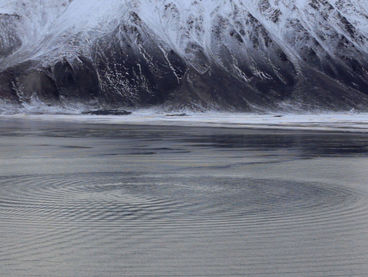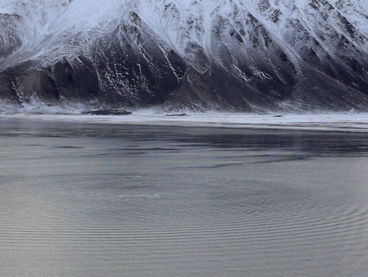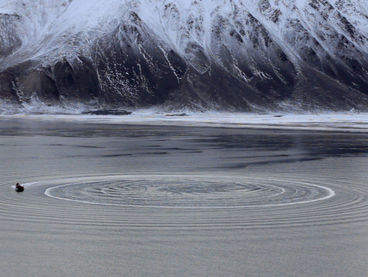MOOZ – audiovisual arts collection
Reign of Silence
2013, 7:20 Min, Color, Sound
Concept and realization: Luxas Marxt
Boatsman: Dan Fisher
Re - recording: Marcus Zilz
After Effects: David Jansen
Grading: Ewald Hentze
Lukas Marxt finds the subjects of his works while traveling to far-flung places: in the bed of a dried-up salt lake in the western United States, on the volcanic wasteland of the Canary Islands, on a drilling platform near the Norwegian coast, or in the isolation of the Arctic.
As in his other works, the landscape shown in Reign of Silence functions both as a backdrop and a protagonist. In this way it serves as a background to the appearance of the motorboat, which glides into view from the side and which performatively and acoustically breaks up the landscape portrait; the landscape is also a backdrop for the wide gaze of the camera. “As the minutes pass, the gaze itself becomes the focus of attention…,” writes Alejandro Bachmann on High Tide and with this names two essential coordinates of Marxt’s interest: addressing the concept of a gaze that captures the landscape and thus transforms it into an image, and the experience of the passing of time. Since only “as the minutes pass” are the different layers of the image successively revealed and come into context and dialogue with each other. The concept of deceleration functions here not as an end in itself but as way to lay bare details and shifts that remain hidden from the restless gaze of constant overstimulation.
At the same time Marxt uses the landscape as a protagonist with which he succeeds in opening up a solidified narrative potential and conveying a sense of various overlapping spheres of time. In this way it proves to be simultaneously a depository of the past, a framework of the present, and an indicator of the future. It is no accident that at the beginning of the video he chooses a clip that contains no visible traces of human intervention and thus refers to prehistoric states of nature. In this setting the appearance of the boat marks the beginning of an incisive shift, an intervention in the process of which the environment is shaped and altered. As the boat’s wake subsides towards the end of the film a future already begins to emerge in which human traces disappear, leveled out by the perpetual transformations of matter.
In only seven minutes Marxt realizes an unpretentious parable on becoming, on the narrow brink of the present, and on the passing of time. Here the water is symbolic with its idiosyncratic, automatic character, such that carving into it can only ever be ephemeral with its continual escape from being domesticated and shaped.
“Ideas, like waves, have fetches,” writes Robert Macfarlane in his book The Wild Places, “‘Wildness’ is such an idea: it has moved immensely through time.” (Macfarlane, Robert: The Wild Places (New York: Penguin, 2007), 29–30.) Marxt is able to capture such immense distance through time in an image and to integrate a human presence in the Before and After of a wild nature that is uninfluenced by human intervention. The Anthropocene is a limited time span, embedded in a disproportionately larger temporal dimension.
All of this takes place in the context of a single uncut shot, a one-shot video. Marxt has become a master of this genre, becoming more sophisticated with later works like Wunderschön und ruhig gelegen (2015) and Circular Inscription (2016). What these works have in common is that their dramaturgy develops out of meandering constellations of individual signifiers within the shot—a montage within a single image.
At the same time the video evokes connections to land art, and here especially to Robert Smithson’s Spiral Jetty, but adds an ironic note through the overlay of the radio transmission in the soundtrack, which takes away any potential severity. The grandeur and the tranquility of the landscape are demystified when we listen in to the director and the boat’s skipper as together they attempt to draw a spiral on the surface of the water as close to the center of the already framed shot.
While the geometric inscription of Spiral Jetty is created out of stone and its erosion over decades deliberately planned, Reign of Silence however makes use of a far more ephemeral and thus transitory gesture, the traces of which are already disappearing the moment they are created.
Text – Daniel Burkhart
Lukas Marxt (*1983 in Schladming, Austria) studied audiovisual design at the University of Arts and Industrial Design Linz, completed the Meisterschüler program at the Academy of Fine Arts Leipzig, and later finished his postgraduate studies at the Academy of Media Arts Cologne.
His work has been shown internationally at various art venues and film festivals, including Hamburger Bahnhof, Kunsthaus Graz, Steve Turner Gallery in Los Angeles, as well as at the Locarno Film Festival, Berlinale, and Ann Arbor Film Festival. In addition, Marxt has received numerous scholarships and awards, such as the Media Arts Award from the German Film Critics Association, the Media Arts State Scholarship from the Federal Chancellery of Austria, and a work scholarship from the Stiftung Kunstfonds.










